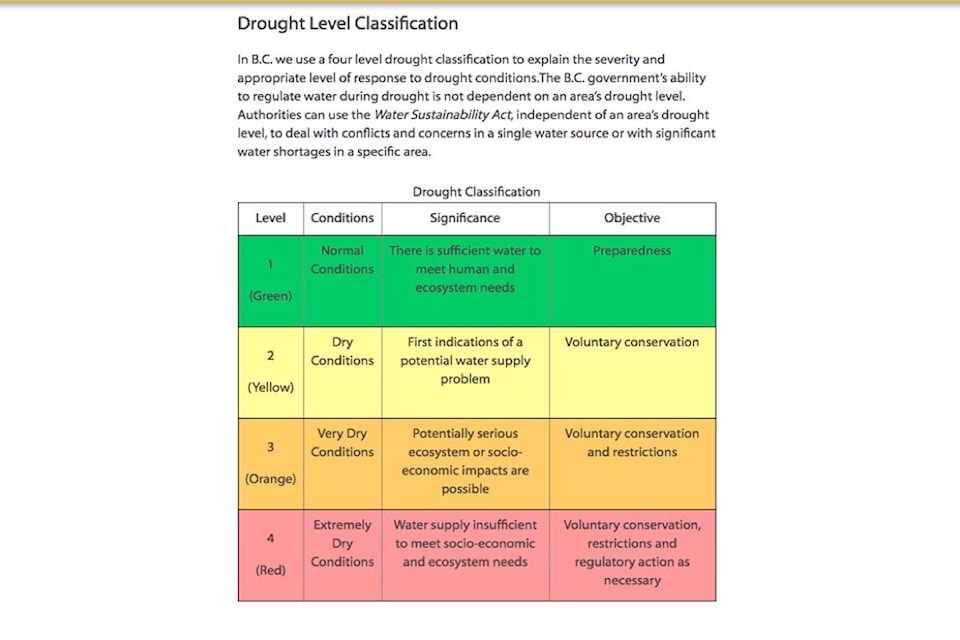Locals are urged to observe their municipally-set water restrictions after the province declared Level 3 drought conditions in the Lower Columbia and West Kootenay on Friday.
The Level 3 classification carries with it “voluntary conservation and restrictions” due to very dry conditions that could lead to potentially serious ecosystem or socio-economic impacts.
Notably, forecasted precipitation in some parts of the province … is not expected to significantly diminish drought levels.
Local municipal water conservation bylaws may differ from provincial water conservation targets due to water supply and demand, and the availability of storage (lakes and reservoirs) or groundwater. Residential, agricultural and industrial water users who are located within municipalities and regional districts are encouraged to observe local water conservation bylaws where they exist.
In the City of Trail, beginning every year on June 1, lawn watering is permitted only on odd numbered days for odd numbered premises and even numbered days for even numbered premises.
Conventional lawn watering, typically a garden hose and sprinkler head, is permitted only during the hours of 6-10 a.m. to and 6-10 p.m. on the designated day.
Automatic sprinkler systems such as underground sprinklers, or other sprinklers that are controlled by an automatic turn on/turn-off device, are permitted from midnight to 10 a.m. and 6 p.m. to midnight on the designated day. Additionally, these automated sprinkler systems must be set to a maximum time of 30 minutes per zone.
Hand watering of gardens and flower beds is permitted any time of the day or evening, provided a flow control device is used. Although not recommended, but if required, washing of sidewalks or driveways is permitted only during the hours of 6 a.m. to 10 a.m. and 6 p.m. to 10 p.m. on the designated day.
Wetting down sidewalks and driveways as a form of cooling is prohibited.
Since July 23, users in the Beaver Valley Water Service have had second stage restrictions in place due to a higher demand on the water system. Those include no hosing of sidewalks or driveways, only one sprinkler permitted at a time, and sprinkling only between the hour of 8 a.m. to 9 a.m. and 8 a.m. to 9 p.m.
The province advises, “Water conservation is everyone’s responsibility.”
Aside from observing local watering restrictions, water conservation tips include: take shorter showers; do not leave the tap running, for example, while brushing teeth; use water-efficient appliances and plumbing fixtures; and ensure irrigation and plumbing systems are well maintained and check for leaks.
Also in Level 3 drought are the East Kootenay, Middle Fraser (Cariboo), Nicola, Coldwater River, Salmon River, South Thompson, Skagit and Nechako areas.
Comparably, the first drought level is classified as normal. That means there is sufficient water to meet human and ecosystem needs, though preparedness is warranted. There are no regions in the province that remain at Level 1 normal streamflow levels the province advised on Aug. 24.
“However, because of the variance of conditions within each region, some individual streams may be lower than others,” the release read. “Both tributaries and larger main-stem rivers are now experiencing rapidly dropping stream levels. Many streams are now at record lows.”
Level 2 is described as dry and calls for voluntary conservation, because conditions are considered the first indicator of a water supply problem.
The situation is considered critical at Level 4.
At this stage, water supply is insufficient to meet socio-economic and ecosystem needs, so voluntary conservation, restrictions and regulation action is necessary. On Friday, the province set a Level 4 drought rating for the Northeast, Northwest, Stikine and Skeena-Nass areas, as well as all of Vancouver Island.
The province has the ability to regulate water usage, including temporary suspension of water licences or short-term water approvals, should it become necessary, to protect flows for fish and for priority water users.
However, the hot and dry conditions that have elevated drought levels have also triggered widespread wildfires throughout the province. In recognition of the need to protect personal property and businesses from these devastating fires, residents are advised that the use of water from streams, lakes or aquifers to extinguish a fire may be necessary and is authorized under the Water Sustainability Act.
Fish and aquatic ecosystems are at risk as water levels drop. Fish can become stranded in pools and exposed to high temperatures, which can be fatal, and may be subject to predation. Water users on all streams are reminded to ensure that water intakes are screened to Fisheries and Oceans Canada standards to prevent fish from being pulled into water systems as water levels drop.
